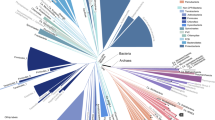Abstract
Based on c. 800 bases from the 5′ end of the 28S rRNA gene, Circaeaster is shown to be a member of the Ranunculales, with Kingdonia as most probable sister-taxon. The ITS2 sequences were too variable to reliably align above the family level, but the sister-group relation of Circaeaster and Kingdonia showed robustness to alterations in alignment parameters and similarity levels comparable to well-established families.
Access this chapter
Tax calculation will be finalised at checkout
Purchases are for personal use only
Preview
Unable to display preview. Download preview PDF.
Similar content being viewed by others
References
Bremer, K., 1988: The limits of amino acid sequence data in angiosperm phylogenetic reconstruction. — Evolution 42: 795–803.
Cronouist, A., 1981: An integrated system of classification of flowering plants. — New York: Columbia University Press.
Foster, A. S., 1971: Additional studies on the morphology of blind vein endings in the leaf of Circaeaster agrestis. — Amer. J. Bot. 58: 263–272.
Genetics Computer Group, 1991: Program manual for the GCG package, ver. 7. — 575 Science Drive, Madison, Wisconsin.
Hoot, S., Crane, P., 1995: Inter-familial relationships in the Ranunculidae based on molecular systematics. — Pl. Syst. Evol. [SuppL] 9: 119–131.
Hu, Z.-H., Yang, J., Jing, R. Q., Dong, Z.-M., 1990: Morphological studies on Circaeaster agrestis II. Morphology and anatomy of flower, fruit and seed. — Cathaya 2: 77–88.
Junell, S., 1931: Die Entwicklungsgeschichte von Circaeaster agrestis. — Svensk Bot. Tidskr. 25: 238–270.
Loconte, H., Campbell, L., Stevenson, D., 1995: Ordinal and familial relationships of Ranunculid genera — Pl. Syst. Evol. [SuppL] 9: 99–118.
Maniatis, T., Fritsch, E. F., Sambrook, J., 1982: Molecular cloning: a laboratory manual. — Cold Spring Harbor: Cold Spring Harbor Laboratory.
Maximowicz, C. J., 1881: Diagnoses Plantarum Novarum Asiaticarum, IV. — Bull. Acad. Sci. St. Petersbourg 27: 425–560.
Nowicke, J. W., Skvarla, J. J., 1982: Pollen morphology and the relationships of Circaeaster, of Kingdonia, and of Sargentodoxa to the Ranunculales. — Amer. J. Bot. 69: 990–998.
Sheen, J.-Y., Seed, B., 1988: Electrolyte gradient gels for DNA sequencing. — BioTechniques 6: 942–943.
Swofford, D., 1993: PAUP: Phylogenetic analysis using parsimony, ver. 3.1.1. — Champaign, Ill. Illinois Natural History Survey.
Takhtajan, A. L., 1969: Flowering plants: origin and dispersal. — Washington DC.: Smithsonian Institution.
Tamura, M., 1993: Ranunculaceae. — In Kubitzki, K., Rohwer, J. G., Bittrich, V., (Eds): Families and genera of vascular plants, 2, pp. 563–583. — Berlin: Springer.
Wu, C.-Y., Kubitzki, K., 1993: Circaeasteraceae.-In Kubitzki, K., Rohwer, J. G., Bittrich, V., (Eds): Families and genera of vascular plants, 2, pp. 288–289. — Berlin: Springer.
Yoon, C.-S., Glawe, D. A., Shaw, P. D., 1991: A method for rapid small-scale preparation of fungal DNA. — Mycologia 83: 835–838.
Author information
Authors and Affiliations
Editor information
Editors and Affiliations
Rights and permissions
Copyright information
© 1995 Springer-Verlag Wien
About this paper
Cite this paper
Oxelman, B., Lidén, M. (1995). The position of Circaeaster — evidence from nuclear ribosomal DNA. In: Jensen, U., Kadereit, J.W. (eds) Systematics and Evolution of the Ranunculiflorae. Plant Systematics and Evolution Supplement 9, vol 9. Springer, Vienna. https://doi.org/10.1007/978-3-7091-6612-3_18
Download citation
DOI: https://doi.org/10.1007/978-3-7091-6612-3_18
Publisher Name: Springer, Vienna
Print ISBN: 978-3-7091-7361-9
Online ISBN: 978-3-7091-6612-3
eBook Packages: Springer Book Archive




